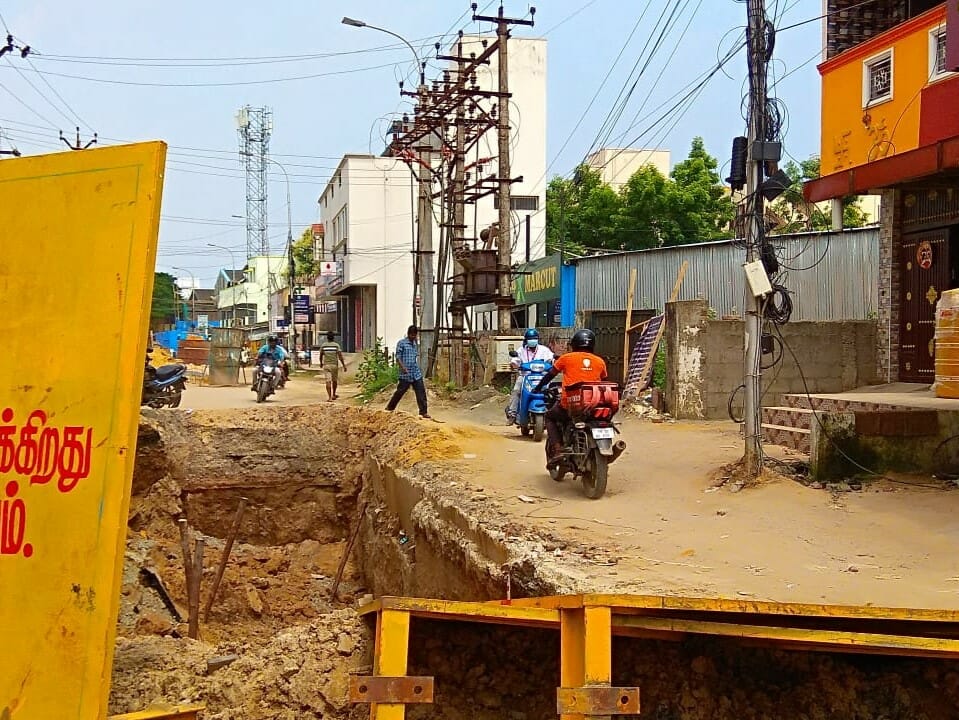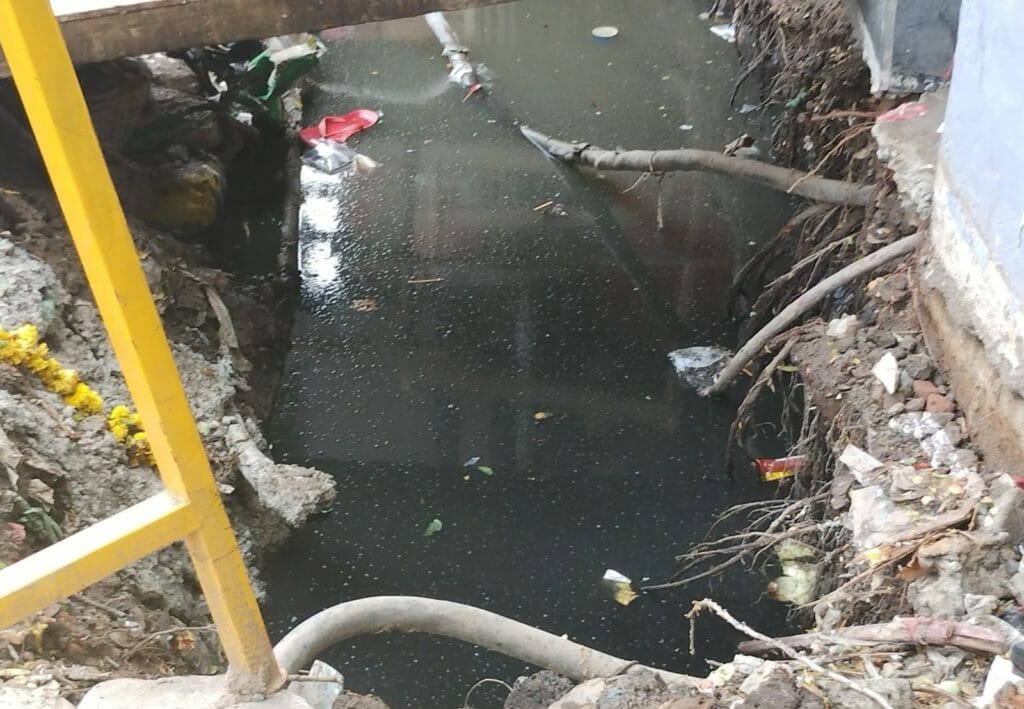If someone from the city were playing Pictionary, and they had to guess from a drawing of floods or inundation, they would probably guess “Chennai” and be right. Flooding and Chennai have become synonymous with each other. No wonder the civic body is hurrying up with storm water drain (SWD) work in Chennai. Will SWDs be the panacea for urban floods?
“No city in the world can rule out inundation [due to rains]. However, it will be much lesser than before in Chennai,” says Gagandeep Singh Bedi, the Commissioner of the Greater Chennai Corporation, when questioned if the current monsoon will make the city repeat its dark history of floods despite the stormwater drains. “Compared to other metro cities, Chennai is doing a much better job [in terms of flood mitigation].”
Lessons from the 2021 floods in Chennai
As per a 2021 report by Council on Energy, Environment and Water, a Delhi-based non-profit think tank, Chennai is the most exposed district to flood and cyclone events among the coastal districts of India.
In November 2021, rains lashed the city, flooding several areas. It was a jarring reminder of the infamous floods in 2015. The city received 4.5 mm of rain less than that of 2015.
Apart from water entering houses and streets being waterlogged, few people were electrocuted, water from major reservoirs like Chembarambakkam and Poondi was released and the winds uprooted the trees. This exposed the gap in flood-resilient infrastructure.
This spurred the government to try and find a permanent solution for Chennai’s floods. A committee headed by the retired IAS officer V Thiruppugazh, who was part of the National Disaster Management Authority (NDMA), was formed to propose flood mitigation solutions. The committee submitted an interim report in January 2022, which is yet to be available to the public.
“We are highly indebted to V Thiruppugazh for his guidance and have incorporated most of his suggestions on stormwater drain design, technology for rainwater harvesting and silt catchpits,” says the Commissioner of GCC.
Implementing SWD work in Chennai
The SWD work began in March 2022. “For a task that should take 10-12 months, we are finishing it in 6-7 months,” says S Rajendiran, the Corporation’s Chief Engineer (CE General).
“97% of SWD work is done. 197 out of 444 missing SWD links are complete, while 3.6 km of drain work is yet to be done,” according to Mayor R Priya who provided updates in a press meet on October 14.
“We have identified 568 locations which were affected due to floods last year, and we are working on them this year [laying effective SWD],” notes the CE.
The Corporation has been desilting the existing drains, replacing defunct or old drains, and laying new drains, apart from connecting missing links. “The new drains will have 3-4 times the earlier capacity,” clarifies the Commissioner.
Moreover, the older brick drains have been incorporated while revamping the defunct drains, as part of Priority-1.
Additionally, to speed up the SWD work, Kolathur saw the use of precast technology. The civic body has completed the drain work in a stretch within 1.5 days which would have taken one month if done using the cast in situ process.
In areas where SWDs have missing links, Corporation said that they would pump out water from minor drains to arterial drains. Chennai sees different levels of precipitation in different areas. “If there is cloudburst, we would make use of higher capacity pumps in more affected areas, and relocate low capacity pumps in less affected areas,” explains S Rajendiran.
SWD is not the only strategy to mitigate floods. “In areas like Thiruvottiyur and Manali, where we are constructing new SWDs, we are including recharge pits along with SWDs. This will ensure water to be harvested, and the excess will be taken away by the drains,” says the Commissioner, adding that recharge pits in core areas could pave way for sewage to mix, and can pollute groundwater.
Furthermore, Chennai Metropolitan Water Supply and Sewerage Board is also creating awareness for government and private buildings to bring about RWH systems.
Read more: Looking beyond stormwater drains to realise the dream of a flood-free Chennai
Funds allocated to SWD work in Chennai
The flood-mitigation funds for Chennai have come from different sources.
- World Bank-funded Tamil Nadu Urban Sustainable Projects focus on areas like Anna Nagar, Kodambakkam, Royapuram and other core zones at a cost of Rs. 120 crores.
- Infrastructure and Amenities funds of Rs. 27 crores focus on some areas in Central Chennai.
- Capital Grants funds of Rs. 7 crores were allocated for Thiru. Vi. Ka Nagar and some zones in North Chennai.
- Singara Chennai 2.0 funds of Rs. 186 crores earmarked for areas like KK Nagar, Ashok Nagar, Vembuliamman Street in Kodambakkam, Seethammal Colony in Teynampet, Rajamannar Road, and Bazullah Road.
A large portion of the funds have been allocated for constructing SWDs in areas with no drains in Chennai- like Thiruvottiyur, Manali, Madhavaram and Ambattur.
“We have also started laying SWDs in Alandur also. This is a long-term project which could get over by 2024,” says the Commissioner.
SWDs to be completed in some areas

Some localities in Chennai did not face any inundation on initial spells of rain. After the rains in early October, there has been no water stagnation in Bazullah Road, Seethammal Colony, Rajamannar Salai in KK Nagar, Mambalam High Road, parts of Velachery West, Kolathur and the Rangarajapuram subway in Chennai, due to working stormwater drains.
However, it is not hunky dory everywhere. “The Corporation has claimed that it has finished 97% of work in Chennai. But, I think only 70% of work is complete in KK Nagar,” says Viswanathan N, a resident of KK Nagar. “Although SWD work is going on KK Nagar, it is very slow. If there are heavy rains for 2-3 days in Chennai, there will be inundation on roads like PT Rajan Salai and Rajamannar Salai.”
Apart from this, the contractors are concentrating more on new drains than revamping the older drains, says Viswanathan, adding that there are missing links still. “Temporary diesel pumps for inundated areas are present in KK Nagar.”
Even though the SWD work is welcome by many residents, they are facing other complications as a result of it.
“While we appreciate that the GCC is revamping the SWDs in Chennai, we are not happy with the execution,” says Raghukumar Choodamani, a resident of Perambur.
“Roads have been dug up in an ad-hoc fashion all over the city. With different contractors being deployed to complete the work within a street forget a Ward or Zone, it appears there is a lack of coordination”, says Raghu.
Side effects of SWD work in Chennai: Dug-up roads
“Although we are satisfied with the pace of the stormwater drain work in our area, the roads are shoddier than ever,” says Preethi Ramadoss, a resident of Mugalivakkam, an area in South Chennai. “I hardly get out of my house these days, as it is difficult to ride a two-wheeler. Also, most cabs or autorickshaws cancel whenever we book via ride-sharing apps.”

It is not just Chennai Corporation areas like Mugalivakkam suffering due to bad roads because of SWD work. Govardhan Raj lives in Kolapakkam, an area near Mugalivakkam. “We have prominent schools near our area, and I have seen parents skid while picking up and dropping off their children”, says Govardhan.
Govardhan lived in Mugalivakkam until recently. “We welcome SWD infrastructure in Chennai, but they are having a piecemeal approach. We wish they complete a stretch [of SWD] at a time and before moving on to other stretches of roads. For instance, they would be doing SWD work, and suddenly they will stop because of some encroachment. So, there is no connectivity.”
Moreover, Preethi and Govardhan urge that they make the inner or alternate roads pucca so that people can at least travel via those routes since the main roads are not proper, since they received information that the civic body will lay the roads in that area only after the rains.
A total of 4146 potholes out of 4916 potholes are yet to be patched up by the Chennai Corporation, and each ward has Rs. 5 lakhs to patch up the roads before the onset of the rains.
“There is a protocol for restoring roads. We will lay a layer of earth in the bottom, and then add wet mix macadam on top of it. Then a layer of concrete will be added,” details the Commissioner on how roads will be restored.
Other issues loom as SWD work is about to be wrapped up
Residents from KK Nagar alleged that old avenue trees were being felled for SWD work. This comes in the wake of a woman dying due to a heavy tree crashing on her car.
“We plant more number of trees than the number of trees being cut,” says the commissioner. “Trees are also being pruned to prevent large trees from falling on people.”
Read more: ‘We don’t want any trees in Chennai’
Some SWD pits also contain sewage water, and they are yet to be closed, as of the first week of October. “It has become a breeding ground for mosquitoes,” says Raghukumar, adding that Perambur faces the issue.

As stormwater drains in Chennai are getting ready to tackle the imminent rains in, the city has to be patched up before the monsoons begin. The city administration is wrapping up all the SWD work by October 15, and IMD has predicted northeast monsoon to begin from the last week of this month in Tamil Nadu.
Residents and the city administration wait with bated breath to see if these efforts pay off in the coming weeks.
Blue green infrastructure is the only solution not grey pipe underground. There are plenty of ways to do this rather than digging and digging to lay concrete pipes underground. Bioswales, trees, permeable grass pavers and creating hedgerows even using mini jali chips can help. This way citizens will not face pot holes and mosquitoes issue due to mixing of sewage.
The Greater Chennai Contractors are providing a Rain Water Recharge borewells inside the Silt Catch Pits along the Storm Water Drains which is a brilliant idea. We as Citizen’s are very sceptical with the manner in which the SWD restoration is being undertaken. With sewage flowing inside the SWD everywhere the Sewage we believe will eventually overflow from the SWD into the borewells and contaminate the ground water table in a water starved city like Chennai. The GCC must put on hold the construction of the Borewells inside the Silt Catch Pits untill the entire SWD restoration work is completed and they are 100% sure that the Sewage Connections into the SWD have been blocked entirely.